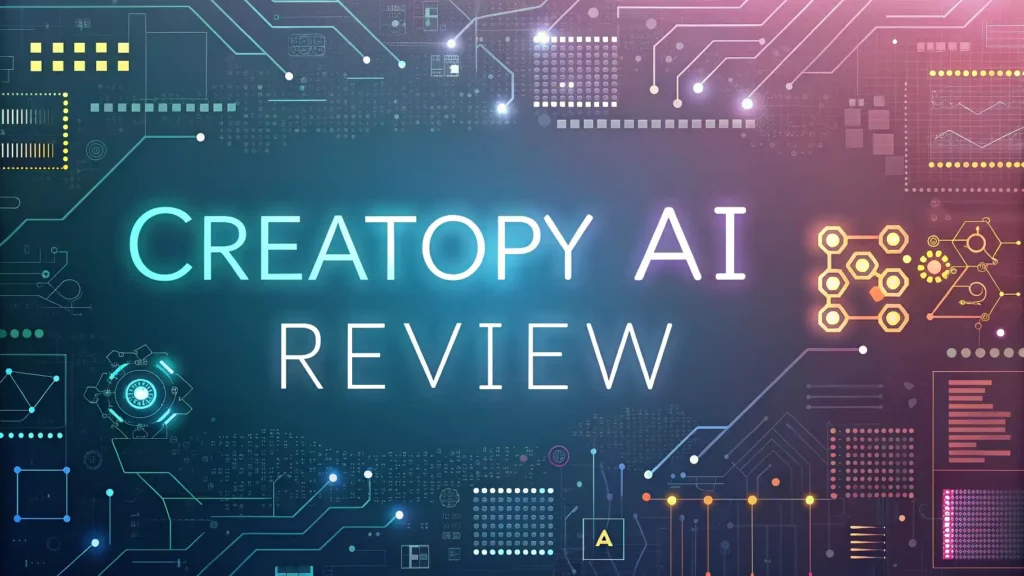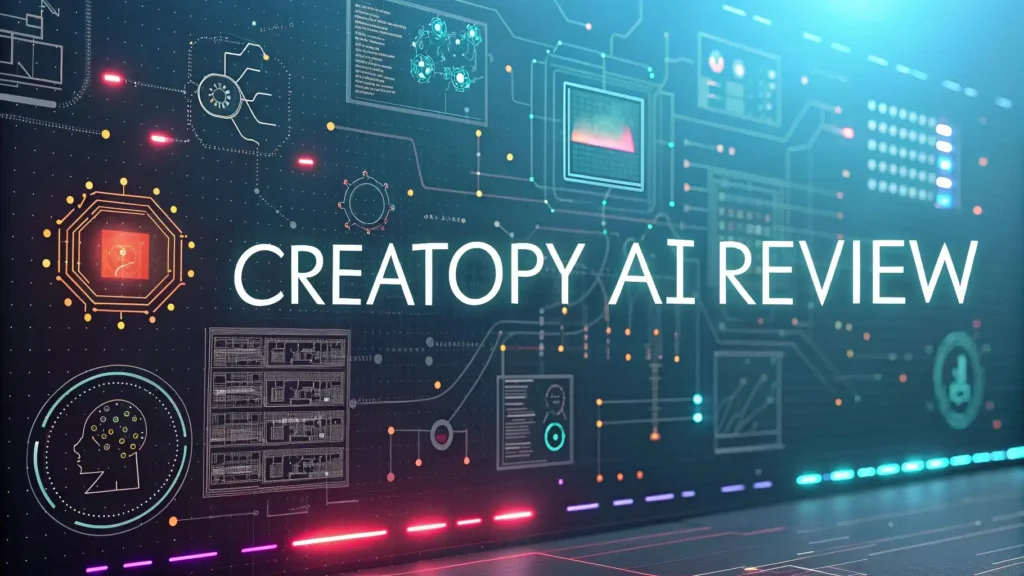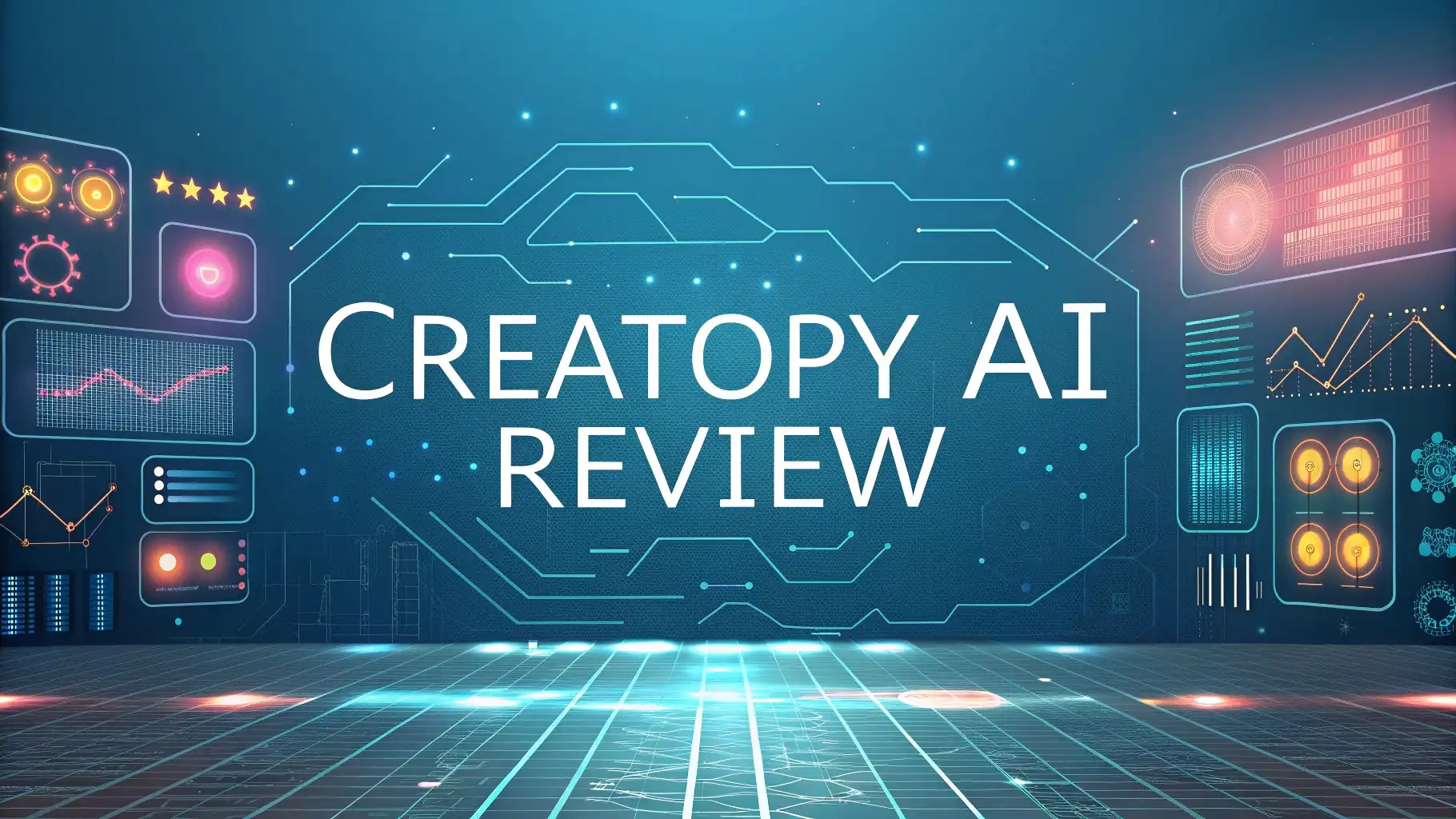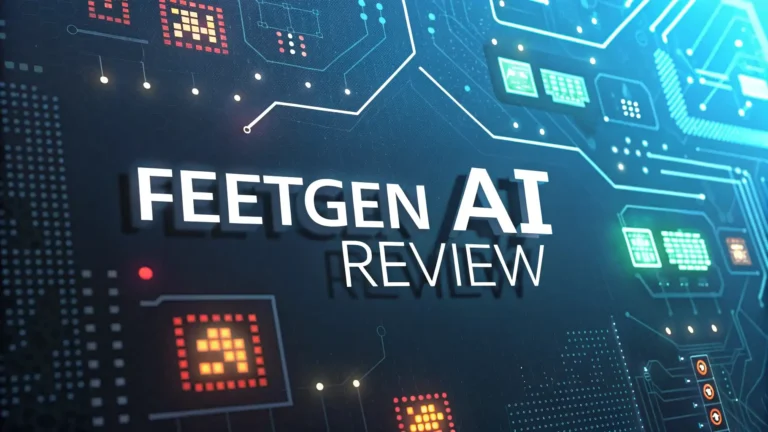Creatopy AI Review in 2025: Guide to AI-Powered Ad Creation
The advertising landscape has evolved dramatically in 2025, and Creatopy AI stands at the forefront of this revolution. This platform has transformed how businesses create, optimize, and deploy digital advertisements through its advanced AI capabilities.
Whether you’re a solo entrepreneur, a marketing team member, or an agency professional, Creatopy AI offers tools that simplify complex design tasks while delivering professional results.
The following comprehensive review explores how Creatopy AI has evolved in 2025, examining its key features, strengths, limitations, and overall value proposition for businesses seeking to enhance their advertising capabilities in an increasingly AI-driven world.

In a Nutshell
- AI Integration Enhancement: Creatopy has significantly expanded its AI capabilities in 2025, offering more sophisticated text and image generation tools that produce remarkably high-quality content.
- Streamlined Workflow: The platform now allows users to generate entire ad campaigns from a single website URL or brief, with AI automatically creating multiple size variants and formats.
- Design Automation: Creatopy’s smart layout builder can generate dozens of design variations while maintaining brand consistency across all assets.
- Cost Efficiency: By reducing production time by up to 80%, Creatopy AI delivers substantial cost savings compared to traditional design processes.
- User Experience: The platform maintains an intuitive interface despite adding complex AI features, making it accessible for users with limited design experience.
- Collaboration Features: Enhanced team workflows allow multiple stakeholders to work simultaneously on projects with AI-assisted feedback and revision tools.
- Competitive Edge: While other platforms offer similar features, Creatopy’s specialized focus on advertising gives it an advantage for marketing-specific applications.
- ROI Potential: Users report improved conversion rates on ads created through Creatopy AI due to professional quality and AI-optimized elements.
- Learning Curve: New users can become proficient within hours rather than days, with AI assistance helping to bridge skill gaps.

The Evolution of Creatopy AI
Creatopy’s journey from its origins as Bannersnack to the AI powerhouse it is today demonstrates the company’s commitment to innovation and adaptation. Founded in Romania by entrepreneur Gabriel Ciordas, the platform underwent a significant transformation when it rebranded from Bannersnack to Creatopy, signaling its expansion beyond simple banner creation into a comprehensive creative automation tool.
In 2025, Creatopy has solidified its position in the market by securing substantial funding for AI development. This investment has allowed the company to build a robust suite of AI tools that address the full spectrum of advertising creation needs. The transition reflects an understanding that modern marketing demands not just design tools but intelligent systems that can amplify human creativity.
The platform now serves thousands of businesses worldwide, from small startups to major enterprises, with its AI-powered solutions. This widespread adoption speaks to both the quality of the technology and the real-world value it delivers to users across different industries and scales of operation.
Creatopy AI Core Features in 2025
AI Banner Generator
The AI Banner Generator represents one of Creatopy’s most powerful tools, allowing users to create entire sets of banner ads in minutes rather than hours. In 2025, this feature has evolved to offer truly impressive capabilities:
The system can now generate complete banner sets from a single website URL, pulling brand colors, images, and messaging automatically. This means you can transform a landing page into a full ad campaign with minimal input. The AI analyzes the source material and creates designs that maintain brand consistency while optimizing for different banner sizes and formats.
What makes this particularly valuable is how the AI adapts content for different dimensions. Rather than simply cropping or resizing elements, it intelligently repositions and scales components to ensure optimal visual hierarchy and readability across all formats. This eliminates the tedious process of manually adjusting designs for different specifications.
Users can generate variations with a single click, allowing rapid A/B testing of different design approaches. The system can produce dozens of alternatives while maintaining brand guidelines, giving marketers a broad selection of options to test in their campaigns.
AI Image Generator
Creatopy’s AI Image Generator has become remarkably sophisticated in 2025, moving beyond basic stock photo alternatives to create truly unique visual assets:
The text-to-image generator now produces incredibly realistic and stylistically diverse visuals from simple prompts. The quality rivals professional photography in many cases, with particular strengths in product visualization and lifestyle imagery. This allows brands to create custom visuals without expensive photo shoots or licensing fees.
Users can specify aspect ratios and visual styles through natural language instructions, making the creation process intuitive even for those without design terminology knowledge. The system understands both technical specifications and creative direction equally well.
One standout feature is the ability to maintain consistent characters or elements across multiple generated images. This enables the creation of cohesive visual narratives across different advertisements without continuity issues.
The platform also includes image editing capabilities powered by AI, allowing for object removal, background changes, and style transfers after initial generation. This combination of generation and editing tools gives users complete control over their visual assets.
AI Text Generator
Copywriting has been transformed by Creatopy’s AI Text Generator, which now serves as a sophisticated writing assistant for advertising content:
The system can generate complete ad copy sets, including headlines, descriptions, and calls-to-action, tailored to specific platforms and formats. It considers character limitations and best practices for different ad placements automatically.
Users can adjust the tone, voice, and style of generated copy to match brand guidelines or target specific audience segments. The AI can produce variations ranging from professional and formal to casual and conversational, with special capabilities for promotional language that drives conversion.
Multi-language support has expanded significantly, now covering over 10 major languages with translation quality that maintains nuance and marketing effectiveness. This allows brands to rapidly deploy campaigns across global markets without waiting for traditional translation services.
The AI can also optimize existing copy, suggesting improvements for clarity, impact, and compliance with advertising guidelines. This serves as both a creativity tool and a quality control mechanism.
Smart Layout Builder
The Smart Layout Builder represents one of Creatopy’s most innovative additions in 2025, fundamentally changing how ad layouts are created:
This tool can generate dozens of layout variations based on a single set of brand assets and content elements. Rather than starting with a blank canvas or template, users can specify their requirements and let the AI suggest optimal arrangements.
The AI analyzes performance data to recommend layouts with proven effectiveness for specific platforms and objectives. This data-driven approach helps marketers leverage best practices without extensive testing or research.
Layout variations maintain perfect brand consistency while exploring different creative approaches, ensuring that experimentation doesn’t come at the cost of brand identity. Elements like logo placement, color usage, and typography remain consistent across variations.
The tool also considers responsive design principles, suggesting layouts that will work well across devices and screen sizes. This future-proofs advertisements in an increasingly fragmented device landscape.
One-Click Animations
Animation has traditionally required specialized skills, but Creatopy’s One-Click Animations feature democratizes this powerful engagement tool:
Users can apply sophisticated animation effects to static designs with a single click, instantly transforming them into eye-catching motion advertisements. The system handles all the complex keyframing and timing automatically.
The AI analyzes the content to suggest appropriate animation styles that enhance the message rather than distract from it. This context-awareness prevents the common pitfall of gratuitous animation that undermines ad effectiveness.
Animation presets are optimized for different platforms, ensuring proper rendering and performance across various advertising networks. This eliminates technical headaches related to compatibility and file size requirements.
Custom animation options allow for fine-tuning when needed, but the AI-generated starting points dramatically reduce the time investment required for motion design.
User Experience and Interface
Despite its sophisticated capabilities, Creatopy maintains an intuitive user experience that makes advanced features accessible to users of all skill levels. The interface has been refined in 2025 to present complex AI tools in approachable ways.
The workspace follows a logical flow from concept to completion, guiding users through each step of the creation process. AI suggestions appear contextually at moments when they’re most useful, rather than overwhelming users with too many options at once.
Template organization has been enhanced with AI-powered search and filtering, making it easier to find relevant starting points. The system learns from user behavior to suggest templates that match previous preferences and project requirements.
Collaboration features have been integrated throughout the interface, allowing team members to provide feedback and make changes seamlessly. This social layer enhances the creative process while maintaining version control and clear communication.
The platform maintains excellent performance even when handling complex AI tasks, with processing typically happening in seconds rather than minutes. This responsiveness keeps creative momentum flowing without frustrating waits for generation or rendering.
Pricing and Plans in 2025
Creatopy offers a tiered pricing structure that scales with user needs, making it accessible for businesses of all sizes:
The Pro plan serves as the entry point for most small businesses and individual marketers, providing access to essential AI features with reasonable generation limits. This plan costs approximately $36 per month when billed annually, offering good value for solo creators and small teams.
The Plus plan expands capabilities for growing businesses, increasing AI generation allowances and adding advanced collaboration features. At around $245 monthly for 5 editors, this tier represents the sweet spot for many marketing teams that need to produce content at scale.
The Enterprise plan delivers unlimited access to all features with custom pricing based on team size and usage requirements. This tier includes dedicated account management and advanced security features that larger organizations require.
All plans include access to the template library, stock asset integration, and basic export formats. Higher tiers add additional export options, more generous AI generation allowances, and advanced team management capabilities.
A 7-day free trial allows users to explore all features without commitment, making it easy to evaluate the platform’s capabilities before purchasing. Importantly, this trial doesn’t automatically convert to a paid subscription, eliminating unwanted charges.
Creatopy AI vs Competitors in 2025
The creative automation space has become increasingly competitive, but Creatopy maintains several distinct advantages over alternatives:
Compared to Canva, Creatopy offers significantly more powerful advertising-specific tools and automation features. While Canva excels at general graphic design, Creatopy’s focus on ad creation provides specialized capabilities that marketing teams find more valuable for campaign production.
Bannerwise represents a direct competitor in the ad creation space, but Creatopy’s AI capabilities have advanced more rapidly, particularly in terms of text generation and layout suggestions. Bannerwise maintains strengths in responsive design but lacks the comprehensive AI assistant features that Creatopy offers.
AdCreative.ai focuses exclusively on AI-generated advertisements but offers less flexibility for customization and brand guideline implementation. Creatopy strikes a better balance between automation and creative control, making it more suitable for brands with established visual identities.
Enterprise solutions like Celtra provide similar capabilities with stronger integration into large marketing technology stacks. However, Celtra’s higher price point and complex implementation make Creatopy more accessible for small to mid-sized organizations.
Creatopy’s advantage lies in its balance of automation and creative control, providing AI assistance without forcing users into rigid templates or limiting their design freedom. This flexibility makes it appropriate for both heavily branded corporate environments and more experimental creative applications.
Real-World Performance and Results
Users report significant improvements in both efficiency and effectiveness when adopting Creatopy AI for their advertising production:
Marketing teams have achieved productivity gains of 70-80% for routine banner production tasks, allowing them to reallocate resources to strategy and analysis rather than execution. This efficiency translates directly to cost savings and faster campaign deployment.
Design quality has improved even for organizations without dedicated design resources, with AI-generated assets often outperforming previous manually created advertisements. This quality improvement leads to better campaign performance metrics, including higher click-through rates.
Experiments with AI-generated variations have led to unexpected creative approaches that human designers might not have considered. This expanded creative territory has helped brands discover new visual and messaging styles that resonate with their audiences.
Consistency across marketing channels has improved substantially, with the AI maintaining brand standards across diverse formats and platforms. This cohesive presentation strengthens brand recognition and professional appearance.
The most successful implementations combine human creativity with AI capabilities rather than relying entirely on automation. Organizations that use Creatopy as a collaborative partner rather than a replacement for human input achieve the best results.
Limitations and Considerations
Despite its impressive capabilities, Creatopy AI has limitations that potential users should consider:
The platform sometimes produces generic designs when prompts lack specificity or brand guidelines aren’t clearly defined. Getting the best results requires learning how to effectively communicate with the AI through detailed prompts and feedback.
Very unconventional or experimental design approaches may still require significant manual intervention, as the AI tends to follow established design patterns and best practices. Highly conceptual or avant-garde advertising may not be the platform’s strength.
Some users report occasional technical issues with the more advanced AI features, particularly during peak usage periods. While generally reliable, the system isn’t entirely immune to performance fluctuations.
The learning curve, while not steep, still requires some investment to fully leverage all capabilities. Organizations should plan for onboarding time to maximize their return on investment.
Budget constraints may be a factor for very small businesses or freelancers, as the more affordable plans limit access to some of the more powerful AI features. The full value proposition is most evident at the Plus tier and above.
User Success Stories
Companies across various industries have achieved remarkable results with Creatopy AI:
An e-commerce retailer reduced their design time for seasonal campaigns by 85% while increasing conversion rates by 23% compared to previous manually designed advertisements. The ability to rapidly test numerous creative approaches contributed significantly to this improvement.
A digital marketing agency expanded their client capacity by 40% without adding design staff by leveraging Creatopy’s automation capabilities. This allowed them to serve more small business clients while maintaining quality and profitability.
A global brand achieved consistent messaging across 12 languages and 24 markets by utilizing Creatopy’s translation and adaptation features. This centralized approach eliminated localization delays that had previously extended campaign timelines.
A travel company created highly personalized destination advertisements for different audience segments, increasing booking rates by 18% compared to their generic campaigns. The ability to rapidly generate variations made this personalized approach economically viable.
These success stories demonstrate the platform’s versatility across different business models and marketing objectives, highlighting its value as a flexible tool rather than a one-size-fits-all solution.
Implementation Best Practices
Organizations that achieve the best results with Creatopy AI typically follow these implementation practices:
Starting with clear brand guidelines and assets ensures that AI-generated content maintains consistency with existing marketing materials. The more comprehensive these guidelines, the better the AI’s output will align with brand identity.
Creating detailed prompt templates for common design tasks helps standardize output and save time on repetitive instructions. Teams can build libraries of effective prompts for different campaign types and objectives.
Establishing workflow processes that combine AI generation with human review leads to better outcomes than either approach alone. The most effective implementations use AI for initial creation and variations, with human designers providing final refinement and approval.
Training team members on prompt engineering techniques significantly improves the quality of AI-generated assets. Understanding how to effectively communicate with AI systems represents a valuable new skill for marketing professionals.
Implementing regular performance reviews of AI-generated content against campaign objectives helps organizations continuously improve their use of the platform. This data-driven approach ensures that efficiency gains don’t come at the expense of effectiveness.
Conclusion: Is Creatopy AI Worth It in 2025?
Creatopy AI has established itself as a leading tool for marketing teams seeking to balance quality, efficiency, and creative control in their advertising production processes. The platform delivers on its core promise of making professional-quality ad creation accessible to users of all skill levels while dramatically reducing production time.
The 2025 version represents a significant advancement over previous iterations, with more sophisticated AI capabilities that produce genuinely impressive results across text, image, and layout generation. These improvements address many of the limitations that earlier creative AI tools faced regarding quality and flexibility.
For most marketing organizations, the efficiency gains and quality improvements justify the subscription cost, particularly at the Plus tier and above where the full range of AI features becomes available. Small businesses and individual creators may find even the entry-level offering provides substantial value compared to manual design processes or general-purpose design tools.
The most successful Creatopy users approach the platform as a collaborative partner rather than a replacement for human creativity. This balanced approach leverages the strengths of both artificial and human intelligence, resulting in advertisements that are both efficient to produce and effective in the market.
For businesses seeking to modernize their advertising production capabilities in 2025, Creatopy AI represents one of the most compelling options available, combining cutting-edge technology with an accessible interface and proven results.
Frequently Asked Questions
What makes Creatopy different from general design tools like Canva?
Creatopy focuses specifically on advertising assets rather than general graphic design. This specialization means its AI tools are trained on advertising best practices and optimized for creating high-performing ads across different formats and platforms. While Canva offers broader design capabilities, Creatopy delivers deeper functionality for ad creation, including format-specific templates, animation features, and advertising-oriented AI assistance.
Does Creatopy AI require design skills to use effectively?
No, Creatopy AI is designed to be accessible to users without formal design training. The AI features compensate for lack of design expertise by suggesting layouts, generating visuals, and creating professional-quality text. However, users with some design knowledge can achieve more customized results by guiding the AI with more specific instructions. The platform works well for both beginners seeking automation and experienced designers looking to increase efficiency.
How does Creatopy handle brand consistency across multiple designs?
Creatopy maintains brand consistency through its Brand Kit feature and AI training. Users can store brand assets including logos, colors, fonts, and style guidelines in a centralized location. The AI uses these elements when generating new designs, ensuring consistent application of brand identity across all assets. This system works particularly well for teams that need to produce high volumes of branded content while maintaining visual coherence.
Can Creatopy AI content be used commercially without copyright concerns?
Yes, all content generated through Creatopy AI is cleared for commercial use. The platform’s terms of service explicitly grant users commercial rights to the content they create using the tool, including AI-generated images, text, and designs. This makes it a safe option for business advertising without the licensing concerns that can arise with some other AI creation tools that have ambiguous ownership terms.
What kind of support does Creatopy offer for enterprise users?
Enterprise users receive dedicated account management and personalized onboarding. This includes customized training sessions, priority technical support, and strategic consultations to maximize platform value. Enterprise plans also include advanced security features, custom integration options, and more flexible payment methods including wired transfers and ACH. This enhanced support ensures larger organizations can successfully implement Creatopy across their marketing teams.
How frequently does Creatopy update its AI capabilities?
Creatopy typically releases major AI feature updates quarterly, with smaller improvements and refinements deployed continuously. The company maintains a public development roadmap that outlines upcoming features and enhancements, allowing users to plan for new capabilities. This regular update schedule helps ensure the platform remains competitive with rapid advancements in AI technology across the industry.
Is Creatopy suitable for video advertising?
Creatopy currently supports animated banner ads and simple motion graphics but is not a full-featured video production platform. Users can create animated ads with transitions, effects, and timing controls that work well for display advertising. For more complex video production, most organizations still need dedicated video editing software, though Creatopy’s roadmap includes expanded video capabilities planned for future releases.
How does Creatopy AI handle multiple languages for global campaigns?
Creatopy offers AI translation features for ad copy in over 10 languages. Users can create content in their primary language and automatically translate it while maintaining marketing intent and tone. The system includes language-specific formatting adjustments to accommodate different text lengths and reading patterns. This capability makes it significantly easier to deploy campaigns across international markets while maintaining message consistency.
What file formats does Creatopy support for exports?
Creatopy supports all standard advertising file formats including JPG, PNG, WEBP, GIF (both static and animated), HTML5, MP4, PDF, and AMP. This comprehensive export capability ensures compatibility with virtually all advertising platforms and content management systems. Higher-tier plans include bulk export features that allow teams to download multiple assets simultaneously in their preferred formats.
Can Creatopy integrate with other marketing tools and platforms?
Yes, Creatopy offers integration with common marketing platforms and file storage systems. This includes connections to Google Drive and Dropbox for asset management, as well as direct publishing capabilities for some advertising networks. Enterprise plans include options for custom API integrations with marketing automation systems, DAM platforms, and other components of the marketing technology stack to create seamless workflows.







